
Samuel Z. Arkoff and his production company American International are responsible for a diverse range of B movies, productions like, Beach Blanket Bingo, Bikini Beach, Blacula, Reform School Girl, Dr. Golfdfoot And The Bikini Machine, Boxcar Bertha, Dragstrip Girl, and The She Creature. These films were made using Arkoff’s special formula. The formula was an acronym based on his name, Action, Revolution, Killing, Oratory, Fantasy, and Fornication. Hardly a groundbreaking recipe.

The Amityville Horror has the Action, the Killing, the Fantasy, and a teeny bit of Fornication. Oratory was supposed to denote notable speeches or dialogue but I’m afraid the movie did not supply that. Of course, anything Rod Steiger, who played a priest, says sounds like an overwrought Shakespearian soliloquy. He is such a ham.

The remaining ingredient is Revolution. This was meant to indicate controversial material. If the presence of the devil is controversial you might get a rise out of some of the religious right but Linda Blaire had already stabbed her loins with a cross in The Exorcist six years prior. It’s hard to beat that (pardon the pun.)
In 1975 Spielberg released what many would call the first modern blockbuster, Jaws. This set Arkoff’s eyes to twinkling and motivated him to try to break out of the B level movie and make his own summer hit. The Amityville Horror was the result. It did not outperform Jaws but still made a lot of money. It cost 4.7 million to make and took in 86.4 million upon release. Arkoff must have been pleased.
It was directed by Stuart Rosenberg who had directed Cool Hand Luke. Amityville is not a bad film but it’s a pretty big step down Cool Hand Luke. The Amityville Horror was based on a book which in turn had been “inspired” by “actual events.” When it comes to the validity of such claims British comedian Jimmy Carr said it best, “It’s actually easy to tell if your house is haunted (pause for timing) It isn’t.”

The main problem with The Amityville Horror is its lack of structure. It wanders through spooky, supernatural occurrences without much rhyme or reason. There is no sense of building tension. It’s supposed to take place over 20 something days and every so often the screen displays “Day 7” or “Day 15” but one day is much like the next. The third act just slowly loses momentum until it grinds to a halt.
There is no shortage of haunted house movies in America. The haunting is almost always due to the house being built on top of some sacred site. Perhaps it’s a metaphor for the American unease with how we originally acquired our real estate. Perhaps it’s about our relationship to our past in general. We hurdle forward from log cabin to tenement, to condo, to high-rise in a blink of an eye. We are a country without deep roots and so we worry about what’s down there.
Although it is doubtful that Stanley Kubrick with his tendency toward extensive research and depth of process was influenced much by The Amityville Horror there is considerable overlap between The Amityville Horror and The Shining. The Amityville Horror has a less nuanced but still similar core story. A new husband finds himself transformed by an evil house and before he knows it he is an ax-wielding murderer out to kill his own family. There is even a scene where the kids are hiding in the bathroom and the father hacks his way through the door with an ax.
Perhaps instead of The Amityville Horror being about property it, like The Shining, is about family. Films from the same era like Poltergeist, The Exorcist, It’s Alive, The Hills Have Eyes, and The Brood all use the American family as their arena. These films reflect the anxiety of a society that fears the breaking up of the family unit. This is the same era as Archie Bunker and George Jefferson who yelled at their progeny, trying to keep them from abandoning conservative, Christian morality.

The house in The Amityville Horror had an availability to undermine morality and replace it with depravity. The clergy are helpless, the police are helpless all the institutions America relies on for law and order are unable to keep the family safe. Of course in the end the family unit triumphs and order is preserved. You don’t get a 4.7 million dollar budget and a contract with American International to make a radical film with a dark and progressive message. You need to make something that will sell. You need to feed the beast, who in this case lives in the basement.

If you enjoyed this article click here for more
www.filmofileshideout.com/archives/why-didnt-anyone-tell-me-about-parents



